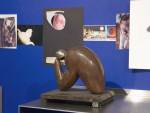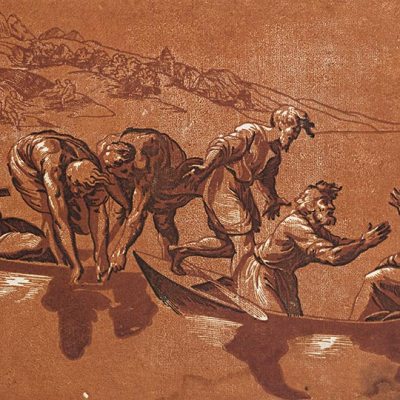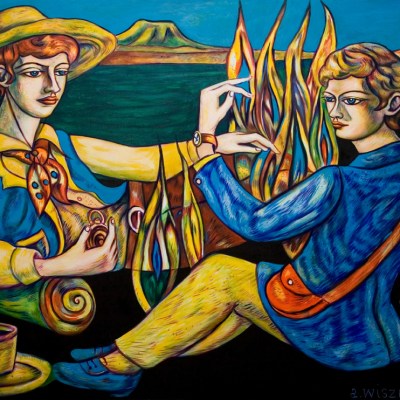French artist Camille Henrot’s first solo UK exhibition at Chisenhale Gallery is like asking a question and receiving a million answers. She’s trying to get to the bottom of things – the show is full of references to origins – but this seems at odds with the dizzying array of stuff that fills the gallery space; abstract sculptures, glossy images torn from magazines, second-hand books, tacky postcards, puzzle pens, kitsch mugs, stacks of National Geographic, retro movie posters, a remote controlled snake. A deliberately overwhelming and seemingly random installation, the result is an excessive theatricality. It’s a hoarder’s paradise and a minimalist’s nightmare.
The title of Henrot’s show, The Pale Fox, is borrowed from a 1965 anthropological study of the West African Dogon people, whose complex mythology – incorporating astronomy, mathematics and philosophy – informs Henrot’s own convoluted study. Here the artist is anthropologist, only her subject is the whole of human evolution, the universe, knowledge itself. This whistle-stop tour through the history of the world takes in art and culture, science and myth. Here are books, the internet, babies, eggs, foxes, wolves, cities, global warming. Wikipedia gone mad.
‘The Pale Fox’ (2014), Camille Henrot. Installation view, Chisenhale Gallery, London, 2014. © ADAGP Camille Henrot. Photo: Andy Keate. Courtesy kamel mennour, Paris and Johan König, Berlin

Yet this totalising project and its chaotic barrage of objects and images – made more fractured by the discordant, looped soundtrack – is not without structure. Each wall corresponds to an element and there’s a timeline of sorts that sees objects arranged along a constructed metal grid. So in the midst of chaos is an evolving order, albeit with many knowing narrative asides.
‘The Pale Fox’ (2014), Camille Henrot. Installation view, Chisenhale Gallery, London, 2014. © ADAGP Camille Henrot. Photo: Andy Keate. Courtesy kamel mennour, Paris and Johan König, Berlin

In this way, Henrot looks to the archive and its attempts to categorise and make sense of the world. In Grosse Fatigue (2013), the film that won her the Silver Lion for most promising young artist at the 55th Venice Biennale, Henrot attempts to process the overwhelming collections held in the Smithsonian Institute, Washington DC – one of the largest museums and a vast repository of knowledge. Her almost childish desire to capture it all means bombarding the viewer with a mix of quick-fire spoken word and disparate, disconnected imagery. No wonder it’s titled Grosse Fatigue; it must be a tiring experience trying to tell the story of the world’s creation in just 13 minutes.
Both this and The Pale Fox obsess over how we store information, how we retrieve it, and how we understand the objects around us. And in Henrot’s storytelling there are no hierarchies; she exhaustively admits multiple thought systems and accepts myriad ways of comprehending the world. The archive, it seems, is much more productive in its very falling apart.
- ‘The Pale Fox’ (2014), Camille Henrot. Installation view, Chisenhale Gallery, London, 2014.
- ‘The Pale Fox’ (2014), Camille Henrot. Installation view, Chisenhale Gallery, London, 2014.
So if Grosse Fatigue is the script then The Pale Fox is the performance. In the Chisenhale, the thoroughly immersive experience of seeing Henrot’s work is made more intense by the blue paint that covers the gallery’s walls. Like being underwater or in the sky, it feels endless. And blue is often associated with calm, which is a necessary antidote to the jumble of disparate works assembled here. It’s also impossible not to think of Yves Klein, and in fact Henrot is deliberate in her references to creativity and art history. Her abstract brush drawings conjure Picasso and in the midst of the second-hand images and eBay purchases are Henrot’s own bronze and ceramic sculptures that draw inspiration from both tribal art and 20th-century modernism. If she turns to creation myths she also looks to the act of creation more generally, to that elusive and age-old creative impulse. It reminds me of how it feels to write – to frustratedly attempt to say everything and to capture something totally.
I write down a quote from a page that Henrot has torn out of one of the National Geographic and stuck on the wall: ‘I am in pursuit of an idea, a story, a chimera, perhaps a folly. I am chasing ghosts.’ Written by journalist Paul Salopek, it refers to his journey retracing the route taken by ancestors who discovered the Earth 60,000 years ago. Salopek’s desire to return to the beginning and his compulsion to connect with a world that is now defined by speed, technology and inattentiveness seems also at the heart of Henrot’s project. In attempting to unravel the history of the universe, we are left with just that – an unravelling. A blue room that, in the end, throws up more questions than answers. It’s a lot to take in. But that, it seems, is the point.
‘Camille Henrot: The Pale Fox’ runs at Chisenhale Gallery, London until 13 April 2014.





